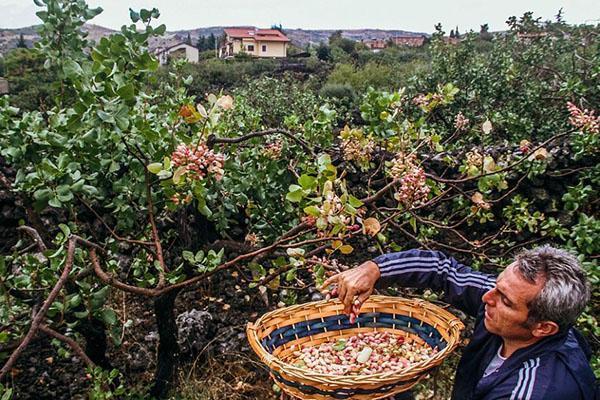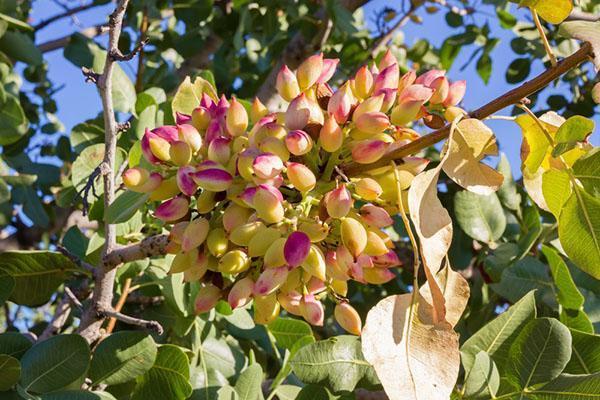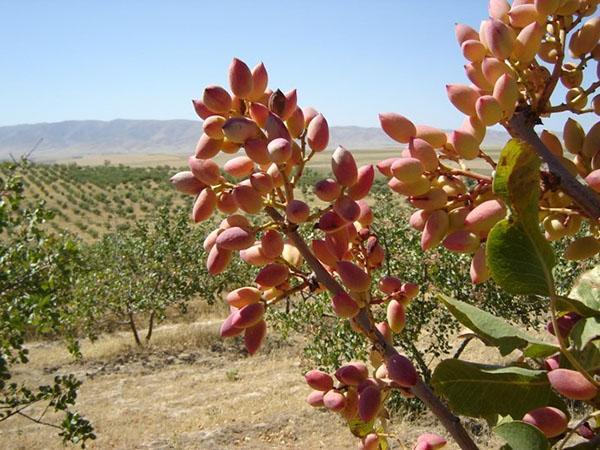Lover of drought and heat - pistachio tree
 The scorching sun and unbearable drought are ideal conditions to grow a pistachio tree in your country house. In the East, home to these green nuts, there are several cities named after them. Moreover, this perennial plant serves as a symbol of Baku, a city that has combined the culture of several eastern peoples. In these parts, and all over the world, green almonds (three times the name) are valued for their incomparable taste. In addition to the creamy aftertaste, gourmets receive a rich "bouquet" of nutrients and nutrients.
The scorching sun and unbearable drought are ideal conditions to grow a pistachio tree in your country house. In the East, home to these green nuts, there are several cities named after them. Moreover, this perennial plant serves as a symbol of Baku, a city that has combined the culture of several eastern peoples. In these parts, and all over the world, green almonds (three times the name) are valued for their incomparable taste. In addition to the creamy aftertaste, gourmets receive a rich "bouquet" of nutrients and nutrients.
Pistachios are also mentioned on the pages of Holy Scripture. Patriarch Jacob ordered his sons to present a luxurious gift to Pharaoh, collecting the best works of the Canaanite land, among which were these nuts.
Read also the article:breadfruit - why is it called that?
"Cradle" of pistachio trees

- Iraq;
- Azerbaijan;
- Syria;
- Iran;
- Turkmenistan.
 Cultivation of these plants began at the end of the 19th century. The United States is still planting kilometer-long plantations and then selling sweet nuts all over the world. The California Peninsula became the cradle of green almonds in the New World. Now the US is fighting Iran for the position of the largest producer of pistachio products. In those areas where the pistachio tree grows, factories are being built nearby that produce flour, essential oils, as well as medical and cosmetic products from their fruits.
Cultivation of these plants began at the end of the 19th century. The United States is still planting kilometer-long plantations and then selling sweet nuts all over the world. The California Peninsula became the cradle of green almonds in the New World. Now the US is fighting Iran for the position of the largest producer of pistachio products. In those areas where the pistachio tree grows, factories are being built nearby that produce flour, essential oils, as well as medical and cosmetic products from their fruits.
 In northwest Africa, breeding of these varieties is also practiced. In the Crimea and the Caucasus, trees are grown exclusively for landscape decoration. Exclusive shrubs seduce visitors to parks, botanical gardens and passers-by on city alleys.
In northwest Africa, breeding of these varieties is also practiced. In the Crimea and the Caucasus, trees are grown exclusively for landscape decoration. Exclusive shrubs seduce visitors to parks, botanical gardens and passers-by on city alleys.  However, in areas with long and cold winters, the crop yield drops by 5 times. At the moment, there are over 20 varieties of culture in the world that are found on all five continents. Some of them can adapt to different climatic conditions (tolerate frost down to -20 ° C).
However, in areas with long and cold winters, the crop yield drops by 5 times. At the moment, there are over 20 varieties of culture in the world that are found on all five continents. Some of them can adapt to different climatic conditions (tolerate frost down to -20 ° C).
The kernels of neon nuts contain a lot of potassium, calcium, iron, protein, as well as vitamins B and E. Therefore, they are recommended to eat for those who have problems with blood pressure and heart disease. Moreover, they are rich in antioxidants, which remove radioactive compounds from the body.
On this topic: How do pistachios grow?
Visa with pistachio tree
To see everything in this world is the property of a few, but only a select few. Therefore, a beautiful photo of a pistachio tree will be an excellent tool for the first acquaintance with it.
In the images, you can carefully consider and also study:
- Leaves. These are dense and large blades, as if polished with wax. Glossy leaves amazingly reflect the rays of the scorching sun on their surface.

- Cron. It consists of chaotically intertwined branches. The semicircular shape of the lush crown creates the look of a knitted hat. The reason for this effect is the "many-sided" trunk, which consists of many separate parts. Therefore, in the "young years" this culture is more like a shrub.

- Flowers.The first inflorescences can be seen in April. They are somewhat reminiscent of grape bunches. These "shaggy" twigs can be either crimson scarlet or ultra-pink.

- Fruit. They are collected in bulky large clusters. At first, the ovaries are pinkish, and over time they turn red. Drying, the peel lightens to a beige tone and opens on one side, like a shell.
 From this gap you can see a pretty light green kernel, the size of which is slightly more than 2 cm. They begin to harvest such a crop already in September.
From this gap you can see a pretty light green kernel, the size of which is slightly more than 2 cm. They begin to harvest such a crop already in September.
Interestingly, the Chinese have dubbed pistachios with a fancy name - "lucky nuts". Because when the fruit ripens, the shell opens slightly, thereby reminding Asians of the charming smile of a child.
Very rarely, such trees reach 10 m in height, 6-8 meters are their maximum indicators. They tolerate dry periods well.  Thanks to the unique structure of the root system, the shoots make their way through the hard rock. So they successfully penetrate moisture, which can lie at a depth of 15 meters. In this case, the roots do not grow too wide, preventing the plants from forming thickets. The maximum area that the rhizome occupies around the trunk is 40 cm.
Thanks to the unique structure of the root system, the shoots make their way through the hard rock. So they successfully penetrate moisture, which can lie at a depth of 15 meters. In this case, the roots do not grow too wide, preventing the plants from forming thickets. The maximum area that the rhizome occupies around the trunk is 40 cm.
With good care from one pistachio tree, a farmer can get over 23 kg of harvest. Fried, raw and even frozen kernels are perfect as a snack for many alcoholic drinks. At the same time, ground nuts are used in confectionery.
Build a house, plant a tree
 This is the mission of every person on earth. At least many people think so. If family members are creative, even exotic, then it is best to grow a pistachio tree at home. Still, it is worth remembering that transplanting is very painful for seedlings. Therefore, while they start, the gardener will have to puff and strain around them well. All the subtleties of this art are reduced to the following stages of work.
This is the mission of every person on earth. At least many people think so. If family members are creative, even exotic, then it is best to grow a pistachio tree at home. Still, it is worth remembering that transplanting is very painful for seedlings. Therefore, while they start, the gardener will have to puff and strain around them well. All the subtleties of this art are reduced to the following stages of work.
Site selection
 Sadly, the temperate climate is not suitable for this perennial plant. Drought, hot summer and "fleeting" winter - that's his lot. If these parameters have been met, then it is worth choosing an open, flat and well-lit area. For indoor varieties, you need to select a dry and as bright place as possible, preferably on the south side of the house.
Sadly, the temperate climate is not suitable for this perennial plant. Drought, hot summer and "fleeting" winter - that's his lot. If these parameters have been met, then it is worth choosing an open, flat and well-lit area. For indoor varieties, you need to select a dry and as bright place as possible, preferably on the south side of the house.
Sapling or Walnut?
 You can propagate a culture in these two ways. The second is the most difficult and much longer than the first. The fruit, together with the shell, should be placed in a container with water. When a sprout (3-5 mm) appears, it can be planted in the sand. After abundant watering, the soil should be covered with the fiber used to create greenhouses. You can remove it when the first shoots appear.
You can propagate a culture in these two ways. The second is the most difficult and much longer than the first. The fruit, together with the shell, should be placed in a container with water. When a sprout (3-5 mm) appears, it can be planted in the sand. After abundant watering, the soil should be covered with the fiber used to create greenhouses. You can remove it when the first shoots appear.
 When buying seedlings, you should immediately purchase two different processes: female and male. Before planting, it is advised to carefully examine the rhizome and carefully cut off the broken / damaged roots.
When buying seedlings, you should immediately purchase two different processes: female and male. Before planting, it is advised to carefully examine the rhizome and carefully cut off the broken / damaged roots.
A number of requirements are imposed on further landing:
- pit depth - one meter;

- several copies need to be planted at a distance of 3 m;

- cover the roots with a substrate of 80% sand and 20% fertile soil, having previously made drainage at the bottom of the pit;

- at the end of the planting process, compact the earth tightly and fill the seedling with a small bucket of water.

Each root cut should be treated with ash so that the living area does not start to rot.
Caring for a pistachio tree involves removing weeds and watering regularly - once every 14 days. In autumn and winter, the plant will go into a sleep stage, so it does not need moisture. But it is important to monitor the condition of the sprout and soil.  Fertilizers must be entered already in the second year of life. To do this, you can choose potash, phosphorus or nitrogen nutritional bases.
Fertilizers must be entered already in the second year of life. To do this, you can choose potash, phosphorus or nitrogen nutritional bases.
 The family will receive the first harvest when the tree reaches 5 years of age. However, growing a plant from a nut, this miracle can only be hoped for in 12 years.In any case, the pistachio tree bears very tasty and healthy fruits. They stimulate the work of the nervous system, heart, liver, and also the male genitals. The daily intake is 15-20 kernels per day. It is calculated depending on the weight of the person.
The family will receive the first harvest when the tree reaches 5 years of age. However, growing a plant from a nut, this miracle can only be hoped for in 12 years.In any case, the pistachio tree bears very tasty and healthy fruits. They stimulate the work of the nervous system, heart, liver, and also the male genitals. The daily intake is 15-20 kernels per day. It is calculated depending on the weight of the person.